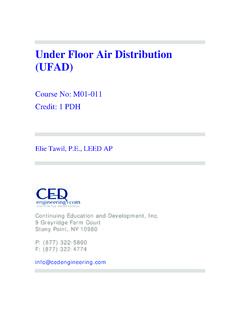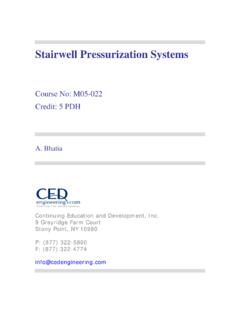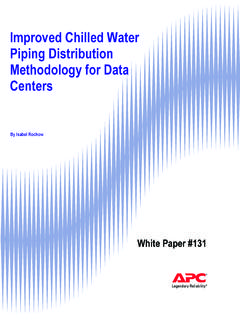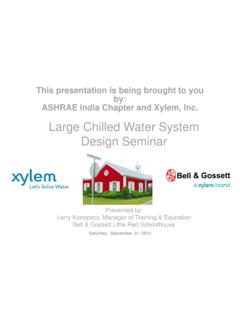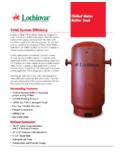Transcription of HVAC Chilled Water Distribution Schemes - CED …
1 hvac Chilled Water Distribution Schemes Course No: M05-008 Credit: 5 PDH A. Bhatia Continuing Education and Development, Inc. 9 Greyridge Farm Court Stony Point, NY 10980 P: (877) 322-5800 F: (877) 322-4774 hvac Chilled Water Distribution Schemes A Chilled Water system is a cooling system in which Chilled Water is circulated throughout the building or through cooling coils in an hvac system in order to provide space cooling. The principal objectives of Chilled Water pumping system selection and design are to provide the required cooling capacity to each load, to promote the efficient use of refrigeration capacity in the plant, and to minimize pump energy consumption subject to whatever budgetary constraints may apply.
2 In the typical design process, such decisions are made on the basis of economic calculations. In Chilled Water systems, pumping normally draws from around 6 to 12 % of the total annual plant energy consumption. Conventional Chilled Water plants distribute Water at constant flow rate, regardless of the actual cooling demand. Since most air-conditioning systems only reach peak load a few hours a year, energy is wasted by continually running the pumps at constant flow (speed). An efficient Distribution system use variable flow that tracks the variable thermal load.
3 This course provides a description of common Chilled Water system types from the most basic constant flow to all variable flow systems along with advantages and limitations. For purposes of discussion, Chilled Water pumping systems are divided into three categories. 1. Constant Volume Chilled Water Systems 2. Primary/Secondary Chilled Water Systems 3. Variable Primary Flow Chilled Water Systems Before we move further, let s briefly refresh the basic hydronic principles: In Chilled Water systems, Water is distributed throughout the entire hydraulic network.
4 The Chilled Water flow rate required for a given heat load is determined as follows: Where: CWFR: Chilled Water flow rate (gal/min) HL: Heat load (BTU/hr)..or chiller capacity D: Liquid density ( Water density = lb/gal) SG: Liquid specific gravity ( Water specific gravity = 1) SH: Liquid specific heat ( Water specific heat = 1 BTU/lb- F) T: Chilled Water temperature differential [ T return Water - T supply Water ] in F Simply stated the Water flow rate is given by equation: Since, the hvac designer s converse more in terms of tons of refrigeration, the equation can be simplified as.
5 OR Note that 1 ton of refrigeration = Heat extraction rate of 12000 BTU/hr Example How many tons of cooling is served by a 6,000 GPM operating at 42 F supply Water temperature and 54 F return Water ? GPM = 6,000 Supply Water temperature = 42 F Return Water temperature = 54 F T in Distribution system = 12 degrees ----- [ 54 F 42 F] LFR = 24/ T = 24/12 = 2 GPM/Ton Tons Cooling = GPM / (24/Delta T) = 6,000/2 = 3,000 tons The example illustrates a very important aspect. For a given design load, the chiller is selected for fixed temperature range T and the associated Chilled Water pumps are selected for calculated flow rate.
6 The Chilled Water supply temperature usually has a fixed set point and the only variable that affects the output capacity of chiller is the return Water temperature. We will learn more in the following sections. Pump Affinity Laws The affinity laws are rules that govern the performance of a pump under varying conditions of flow and pressure. The laws can be roughly stated as follows: Flow varies with rotating speed Head varies with the square of the rotating speed Brake horsepower varies as the cube of the rotating speed Example A Chilled Water pumping system delivers 10000 GPM @ 240 BHP.
7 What is the approximate required pumping horsepower the flow rate is cut to half by variable speed drive on the pumps? 10,000 GPM requires 240 BHP 5,000 GPM requires what BHP? Q1 = 10,000 GPM, Q2 = 5,000 GPM, BHP1 = 240 BHP2 = BHP1 (Q2/Q1)3 or BHP2 = 240(5,000/10,000)3 = 240/8 30 BHP The example illustrates another important aspect. If the flow rate were 50% of the design flow, half the higher flow rate then the power necessary to provide the slower flow rate would be ( )3 = or % of the power required for the higher flow rate.
8 It means an energy saving of %. Such savings justify the applications of variable speed pumping in Chilled Water Distribution Schemes , which we will study in following sections. _____ SCHEME #1 CONSTANT FLOW Chilled Water SYSTEM A constant flow system is the simplest Chilled Water Distribution scheme. Here, a set of constant speed pumps distributes fixed quantity of Water at all times and the temperature varies to meet the load. The system uses 3-way control valves at air handler coils that allow some Water to bypass the cooling coil during part load conditions.
9 At low loads, the Chilled Water flow through the cooling coil is restricted (in response to supply air temperatures to the space) but the total quantity returned to the chiller remains constant. Figure below shows the schematic of the constant-flow rate primary system. Looking at the equation that governs heat transfer, the capacity of a chiller is proportional to the product of flow rate and the temperature difference of entering and leaving Chilled Water , or chiller capacity (BTU/hr) = GPM x 500 x T In constant-flow systems, flow rate ( GPM) is established for peak design condition and Delta-T (the difference between the chiller supply and return) varies in reponse to the load (BTU/hr).
10 In air-conditioning applications, since the design conditions occur only during 1% of the operational hours in a year [ 99% of the time the system runs on part load], some of the Chilled Water will always bypass through the three-way valve for most of coil s operational life. Higher quantities of bypassed Chilled Water mixes with leaving Water from the cooling coil yielding lower Chilled Water return temperature to the plant. The lower return Water temperature reduces the operating temperature differential ( T) across the chiller as the supply Water temperature is fixed to a setpoint.


